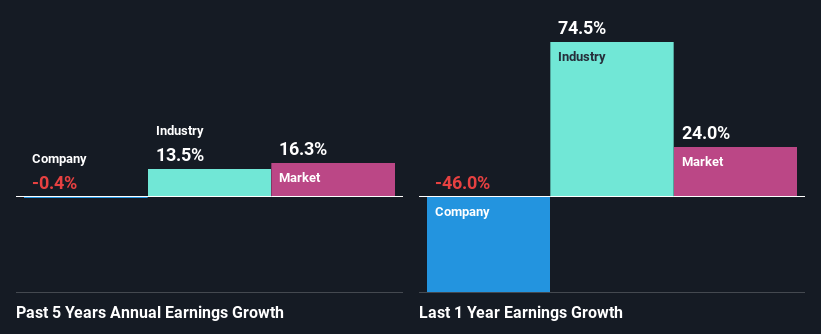Is Acadian Timber Corp.'s (TSE:ADN) Recent Performancer Underpinned By Weak Financials?
It is hard to get excited after looking at Acadian Timber's (TSE:ADN) recent performance, when its stock has declined 8.7% over the past three months. To decide if this trend could continue, we decided to look at its weak fundamentals as they shape the long-term market trends. In this article, we decided to focus on Acadian Timber's ROE.
Return on equity or ROE is a key measure used to assess how efficiently a company's management is utilizing the company's capital. Put another way, it reveals the company's success at turning shareholder investments into profits.
View our latest analysis for Acadian Timber
How Do You Calculate Return On Equity?
The formula for return on equity is:
Return on Equity = Net Profit (from continuing operations) ÷ Shareholders' Equity
So, based on the above formula, the ROE for Acadian Timber is:
5.9% = CA$17m ÷ CA$290m (Based on the trailing twelve months to March 2022).
The 'return' is the yearly profit. So, this means that for every CA$1 of its shareholder's investments, the company generates a profit of CA$0.06.
What Is The Relationship Between ROE And Earnings Growth?
So far, we've learned that ROE is a measure of a company's profitability. Depending on how much of these profits the company reinvests or "retains", and how effectively it does so, we are then able to assess a company’s earnings growth potential. Assuming everything else remains unchanged, the higher the ROE and profit retention, the higher the growth rate of a company compared to companies that don't necessarily bear these characteristics.
Acadian Timber's Earnings Growth And 5.9% ROE
When you first look at it, Acadian Timber's ROE doesn't look that attractive. A quick further study shows that the company's ROE doesn't compare favorably to the industry average of 24% either. Hence, the flat earnings seen by Acadian Timber over the past five years could probably be the result of it having a lower ROE.
As a next step, we compared Acadian Timber's net income growth with the industry and discovered that the industry saw an average growth of 13% in the same period.
Earnings growth is an important metric to consider when valuing a stock. It’s important for an investor to know whether the market has priced in the company's expected earnings growth (or decline). This then helps them determine if the stock is placed for a bright or bleak future. Has the market priced in the future outlook for ADN? You can find out in our latest intrinsic value infographic research report.
Is Acadian Timber Efficiently Re-investing Its Profits?
The high three-year median payout ratio of 88% (meaning, the company retains only 12% of profits) for Acadian Timber suggests that the company's earnings growth was miniscule as a result of paying out a majority of its earnings.
In addition, Acadian Timber has been paying dividends over a period of at least ten years suggesting that keeping up dividend payments is way more important to the management even if it comes at the cost of business growth. Our latest analyst data shows that the future payout ratio of the company is expected to rise to 117% over the next three years. However, the company's ROE is not expected to change by much despite the higher expected payout ratio.
Summary
In total, we would have a hard think before deciding on any investment action concerning Acadian Timber. As a result of its low ROE and lack of much reinvestment into the business, the company has seen a disappointing earnings growth rate. Having said that, looking at current analyst estimates, we found that the company's earnings growth rate is expected to see a huge improvement. To know more about the latest analysts predictions for the company, check out this visualization of analyst forecasts for the company.
Have feedback on this article? Concerned about the content? Get in touch with us directly. Alternatively, email editorial-team (at) simplywallst.com.
This article by Simply Wall St is general in nature. We provide commentary based on historical data and analyst forecasts only using an unbiased methodology and our articles are not intended to be financial advice. It does not constitute a recommendation to buy or sell any stock, and does not take account of your objectives, or your financial situation. We aim to bring you long-term focused analysis driven by fundamental data. Note that our analysis may not factor in the latest price-sensitive company announcements or qualitative material. Simply Wall St has no position in any stocks mentioned.
Join A Paid User Research Session
You’ll receive a US$30 Amazon Gift card for 1 hour of your time while helping us build better investing tools for the individual investors like yourself. Sign up here

 Yahoo Finance
Yahoo Finance 
